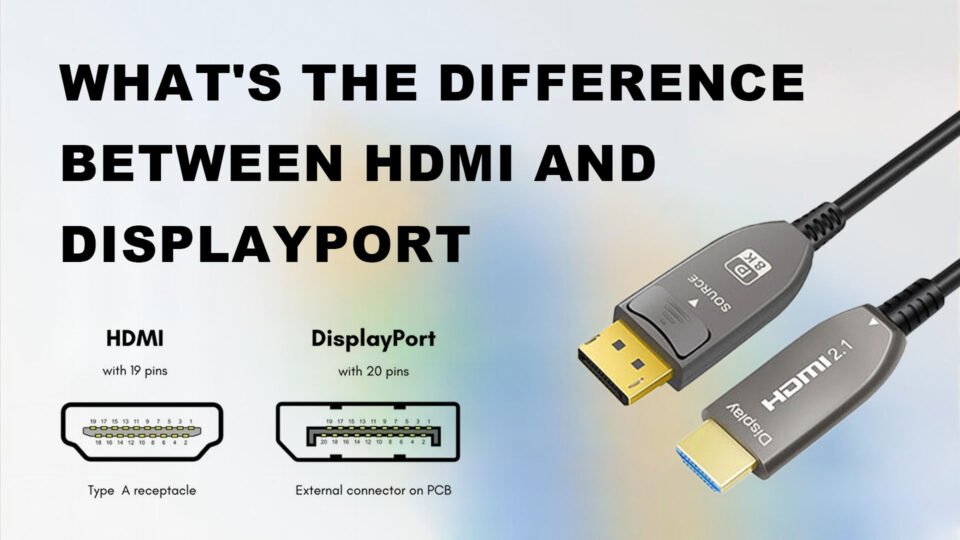- Understanding Armored Optical Fiber HDMI AOC Cables
- The main differences between Armored and Standard 8K Optical Fiber HDMI AOC Cables lie in their construction and protective capabilities:
- Advantages and Disadvantages of Armored 8K Optical Fiber HDMI AOC Cables
- Renowned Manufacturers of 8K Optical Fiber HDMI AOC Cables
- AOCFiberlink: A Superior Choice for Armored 8K Optical Fiber HDMI AOC
- FAQ
- Über uns
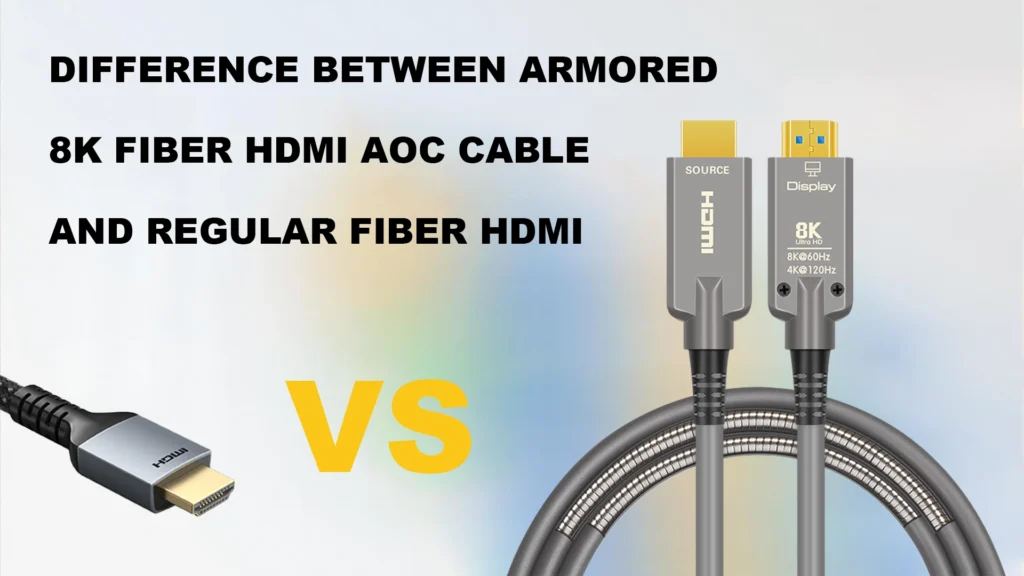
Armored 8K Optical Fiber HDMI AOC Cable vs. Standard 8K Optical Fiber HDMI AOC Cable: What’s the Difference?
With the continuous development of 8K technology, the demand for reliable and high-quality HDMI cables for transmitting high-resolution video is becoming increasingly important. Both armored 8K optical fiber HDMI AOC cables and standard 8K optical fiber HDMI AOC cables offer excellent performance. However, they differ significantly in terms of design, durability, and intended use. This article will explore the main differences between these two types of cables to help you make an informed choice.
Understanding Armored Optical Fiber HDMI AOC Cables
Armored optical fiber HDMI AOC cables are a special type of HDMI Active Optical Cable (AOC) characterized by an additional protective layer around the fiber optic core. Unlike traditional HDMI cables that use copper conductors, AOC cables utilize fiber optic technology to transmit signals over long distances without compromising quality. The term “armored” refers to the cable being reinforced with a sturdy protective material, such as metal or Kevlar fibers, capable of withstanding harsh environments, physical impacts, and everyday wear and tear.
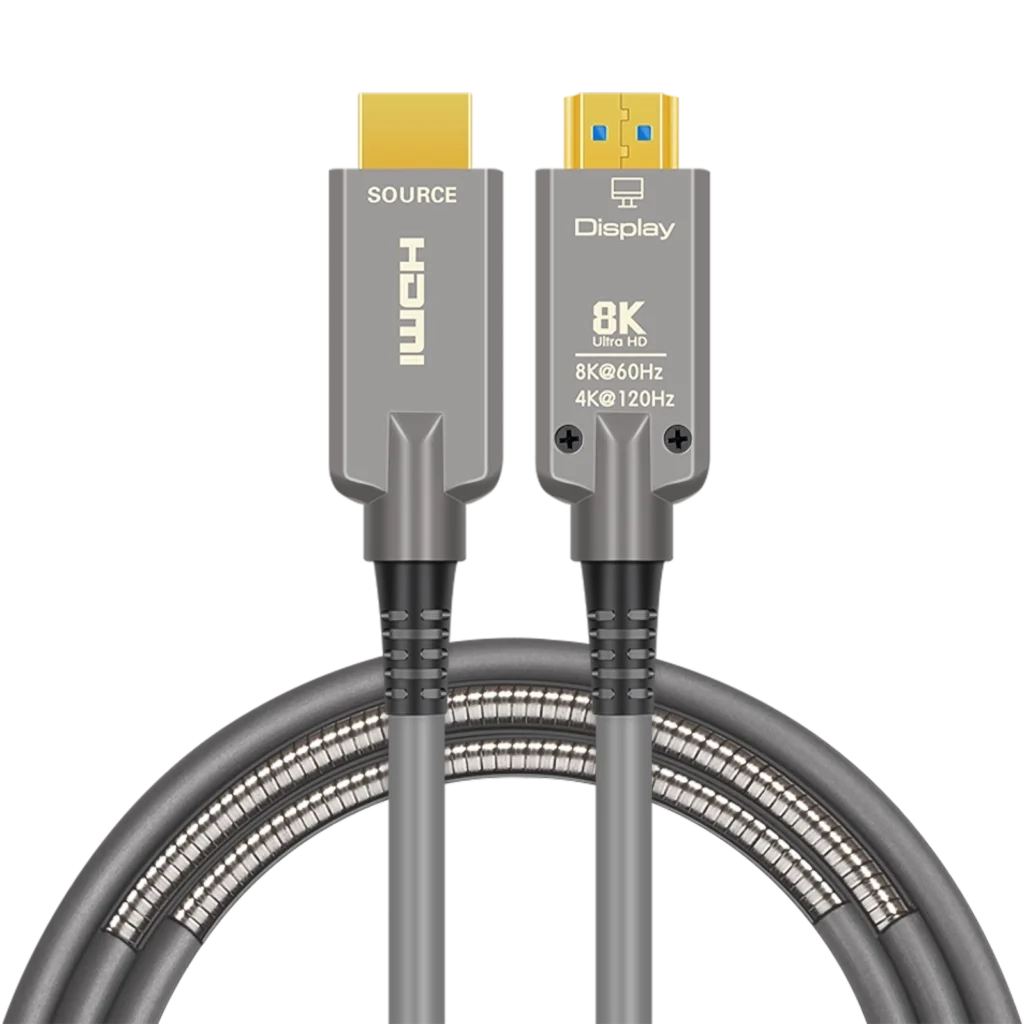
This enhanced durability makes armored cables particularly suitable for challenging applications, including rental services, outdoor events, and scenarios where cables are frequently relocated or exposed to potential hazards.
The main differences between Armored and Standard 8K Optical Fiber HDMI AOC Cables lie in their construction and protective capabilities:
Durability: Armored cables are made with materials like steel braid or Kevlar fibers, providing them with excellent resistance to physical damage, capable of withstanding being run over by a vehicle without deformation. In contrast, standard cables lack this extra protection and are more prone to breaking in challenging environments.
Flexibilität: Without the armor, regular 8K HDMI AOC cables tend to be more flexible and lighter. Conversely, armored cables are usually stiffer and heavier, which may reduce their flexibility but greatly enhances their durability.
Use Cases: Regular 8K HDMI AOC cables are ideal for stable environments like home theaters or office spaces, while armored 8K HDMI AOC cables are designed for demanding conditions with frequent movement, such as live events, rental applications, and stages.
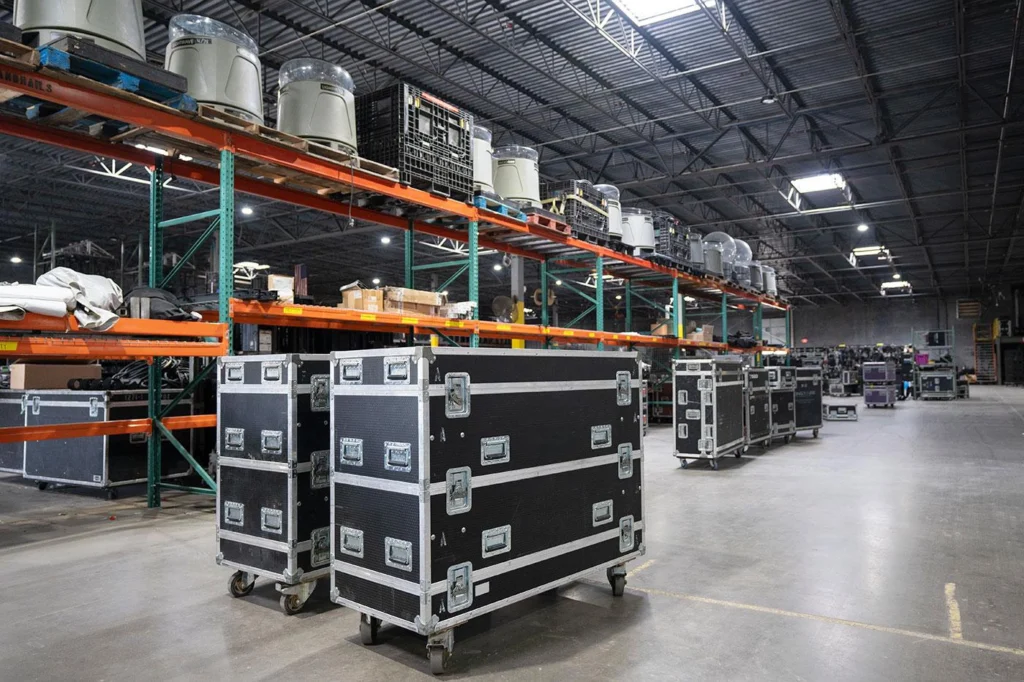
Cost: Armored cables are typically more expensive due to their additional protective features. However, this cost is justified by their superior durability and longer lifespan.
The table below compares the armored 8K optical fiber HDMI AOC cables with the standard version.
| Feature | Armored 8K HDMI AOC | Regular 8K HDMI AOC |
|---|---|---|
| Durability | High durability with metal armor, highly resistant to physical damage | Moderate durability; can be susceptible to physical stress and bending |
| Material | Reinforced with metallic or stainless steel armor | Generally made with standard fiber-optic or plastic insulation |
| Flexibility | Slightly less flexible due to armored layer | More flexible, suitable for tighter bends |
| Installation Environments | Ideal for industrial or heavy-duty applications where cable protection is critical | Better for regular home or office setups where extreme durability isn’t necessary |
| Protection | Superior resistance to cuts, abrasions, and impacts | Less resistant to physical damage compared to armored versions |
| Cable Diameter | Slightly larger due to additional protective layer | Slimmer and lighter in comparison |
| Weight | Heavier due to armored material | Lighter, making it easier to manage |
| Cost | Generally higher due to extra materials and construction | More affordable, suitable for general consumer use |
| Common Uses | Industrial applications, public installations, harsh environments | Home theaters, offices, general AV setups |
| Cable Structure |  |
 |
| Product Photo | 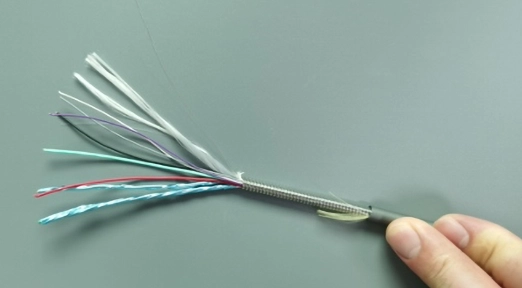 |
– |
Advantages and Disadvantages of Armored 8K Optical Fiber HDMI AOC Cables
Vorteile:
Strong Protection: Armored cables provide excellent defense against physical damage, making them suitable for harsh environments.
Extended Durability: The reinforced structure ensures a longer lifespan, even under demanding conditions.
Excellent Long-Distance Signal Integrity: Similar to standard optical fiber HDMI AOCs, the armored version maintains superb signal quality over distances up to 500 meters.
Disadvantages:
Limited Flexibility: The extra protection restricts flexibility compared to ordinary fiber HDMI AOCs, which may not be suitable for tight spaces.
Increased Cost: The need for enhanced materials and manufacturing techniques results in a higher price for armored cables.
Heavier Weight: Armored fiber HDMI cables are typically heavier than standard fiber HDMI cables, which may pose challenges for portable setups.
Renowned Manufacturers of 8K Optical Fiber HDMI AOC Cables
Many well-known manufacturers produce top-tier 8K optical fiber HDMI AOC cables, available in both armored and non-armored types. Notable brands include:
Fibercommand: Known for its premium fiber optic HDMI solutions featuring cutting-edge capabilities.
Cable Matters: Offers a range of HDMI AOC options celebrated for reliability and performance.
AOCFiberlink: A brand focusing on fiber optic connectivity, emphasizing robust and high-performance HDMI AOC solutions.
FIBBR: Renowned for its durable and high-quality HDMI fiber optic cables, perfect for home theater and gaming environments.
Ruipro: Known for its HDMI AOC cables that support high-resolution and long-distance transmission.
These manufacturers offer various levels of features and durability to meet different requirements and applications.
AOCFiberlink: A Superior Choice for Armored 8K Optical Fiber HDMI AOC
AOCFiberlink has become a trusted brand in the fiber optic connectivity industry, offering high-quality, durable, and competitively priced HDMI AOC solutions. Here’s why AOCFiberlink’s armored 8K optical fiber HDMI AOC stands out:
1.Cinema-Grade Audiovisual and Gaming Experience
An excellent choice for rentals in outdoor activities like large stage concerts.

The armored 8K optical fiber HDMI AOC cable, utilizing HDMI 2.1 technology, excels in video quality and significantly enhances audio experiences. Through enhanced Audio Return Channel (eARC), it supports high-quality audio formats, ensuring cinema-grade audiovisual experiences and full compatibility with 7.1/5.1 surround sound systems. Dolby Atmos support offers a three-dimensional audio experience, enveloping the audience in realistic sound.

For gaming enthusiasts, these cables support Variable Refresh Rate (VRR), greatly enhancing visual responsiveness. By synchronizing the frame rates between the monitor and GPU, the cable eliminates screen tearing and stuttering, ensuring a smooth gaming experience. They are fully compatible with the latest gaming monitors and TVs utilizing VRR technology.
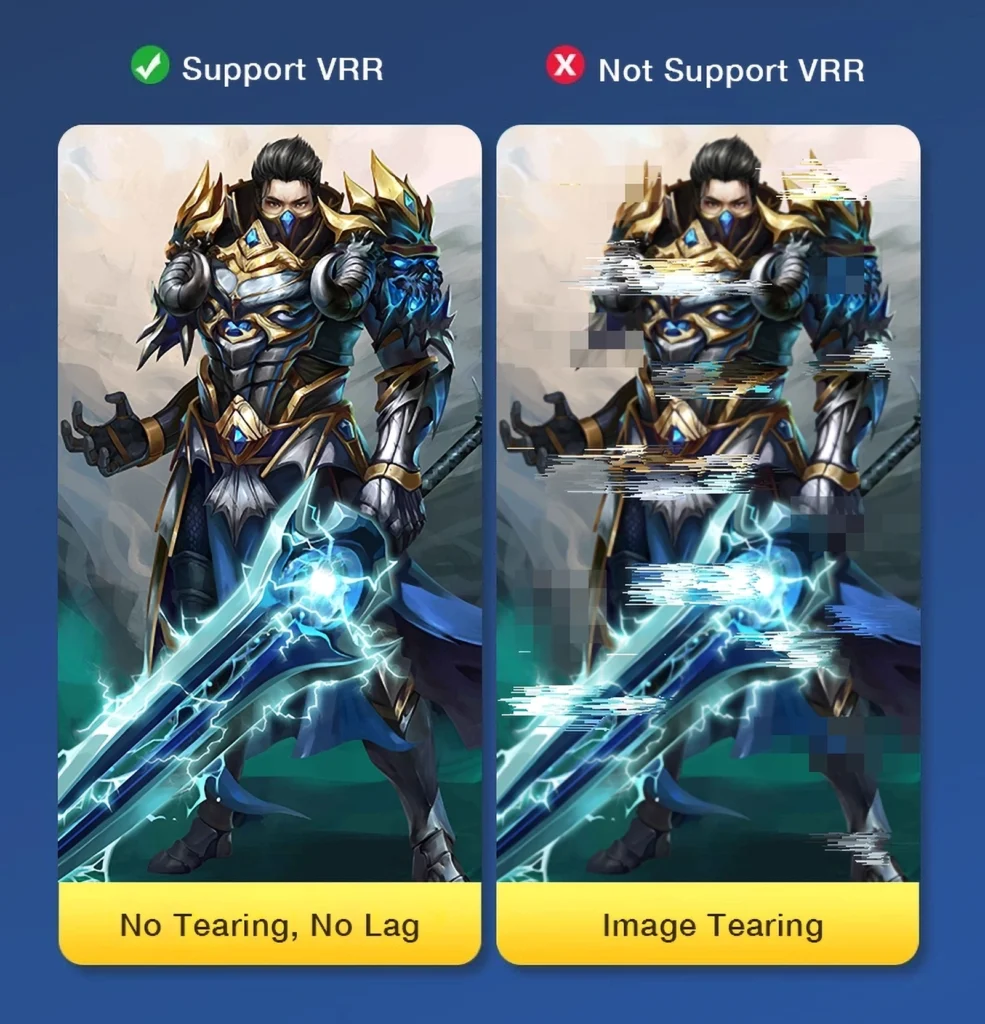
These cables are also designed to provide an astounding 8K 60Hz immersive visual experience, integrating advanced HDMI 2.1 technology. The 8K/60Hz high resolution ensures every detail is vivid and clear, while the 48Gbps high-speed bandwidth transmits high-resolution content without delay or quality loss. Coupled with HDR visuals, they enhance contrast and color range, offering realistic and vibrant visuals.
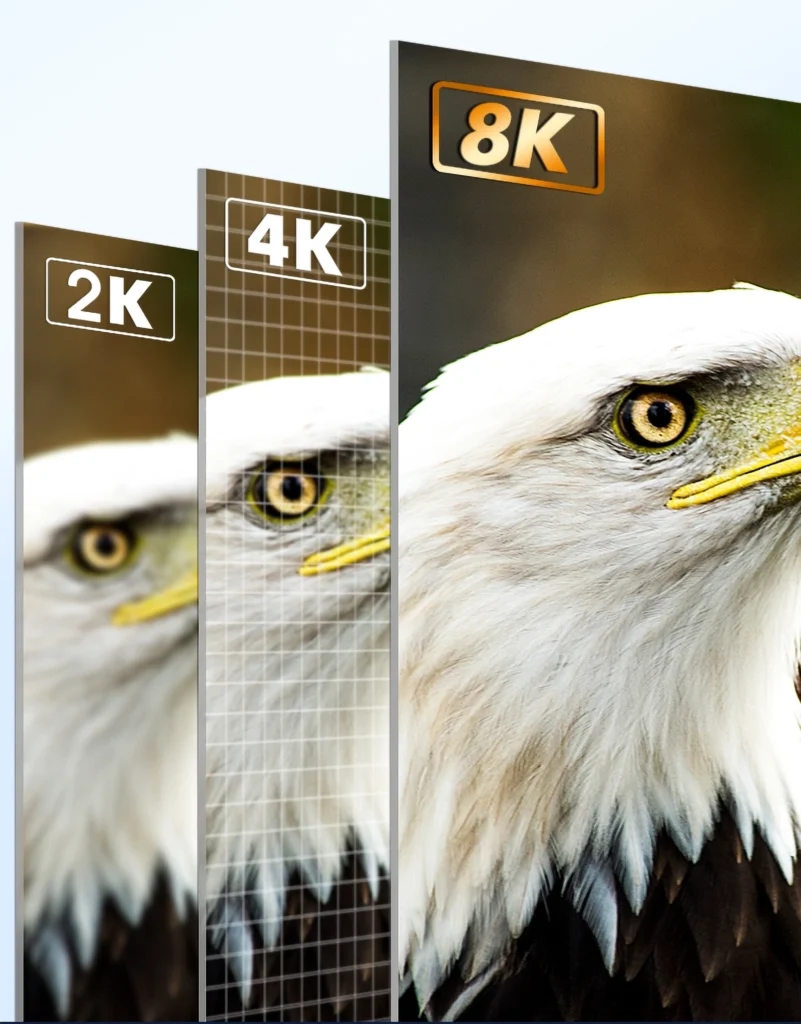
2.Advanced Transmission Technology
Armored 8K optical fiber HDMI AOC cables are equipped with 4-core 12G optical fiber cores, ensuring high-speed data transmission and minimizing signal loss over long distances. Multi-strand tinned copper cores provide additional strength and conductivity, and Kevlar fiber reinforcement significantly enhances tensile strength, enabling the cable to resist physical stress. Aluminum foil shielding prevents electromagnetic interference, ensuring stable signal transmission, while fine steel armor and UL-rated flame-retardant TPU add durability and safety, offering extra protection in adverse environments.
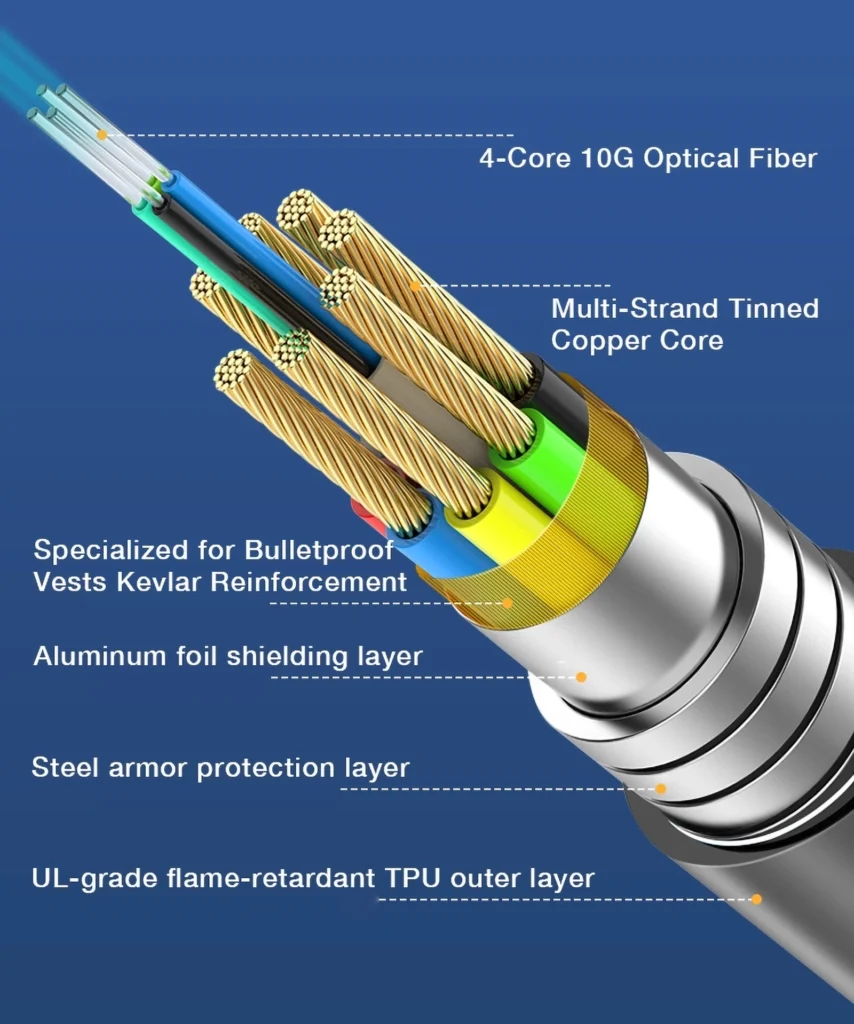
Employing 48G optical fiber technology, these cables deliver nearly lossless signal transmission over 500 meters, crucial for high EMI environments. They possess strong immunity to electromagnetic interference, ensuring reliable signals in challenging environments and achieving high-speed data transmission without delay, suitable for large-scale installations.

3.Cutting-Edge Chips and Years of Research Technology
THe armored 8K optical fiber HDMI AOC cables are equipped with high-performance photonic chips imported from Germany’s Silicon Line, combined with over 20 years of experience in high-frequency signal transmission and 8 years of specialized research in photonic transmission technology. This ensures the cable’s performance and quality are fully guaranteed.
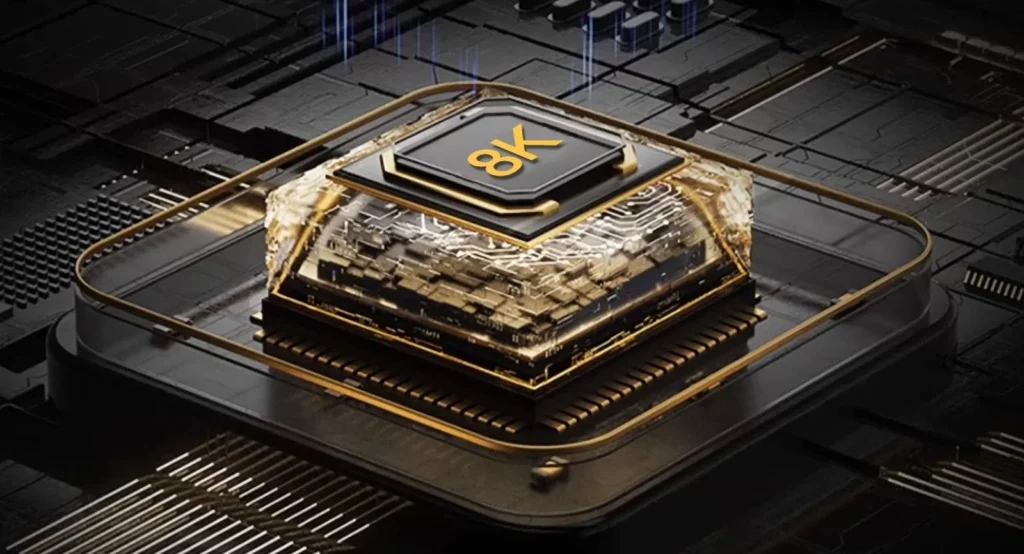
High-Performance Photonic Chips: Maintain signal integrity over long distances, ensuring lossless high-resolution video and audio transmission.
Collaborative Development: Developed in collaboration with leading chip solution manufacturers to achieve state-of-the-art technology and reliability.
Comprehensive Quality Assurance: Manufactured and sold within our facilities to ensure strict quality control and assurance.
4.Premium Material Technology
This armored fiber HDMI cable is meticulously designed with premium materials to ensure durability and exceptional performance in the most challenging environments.
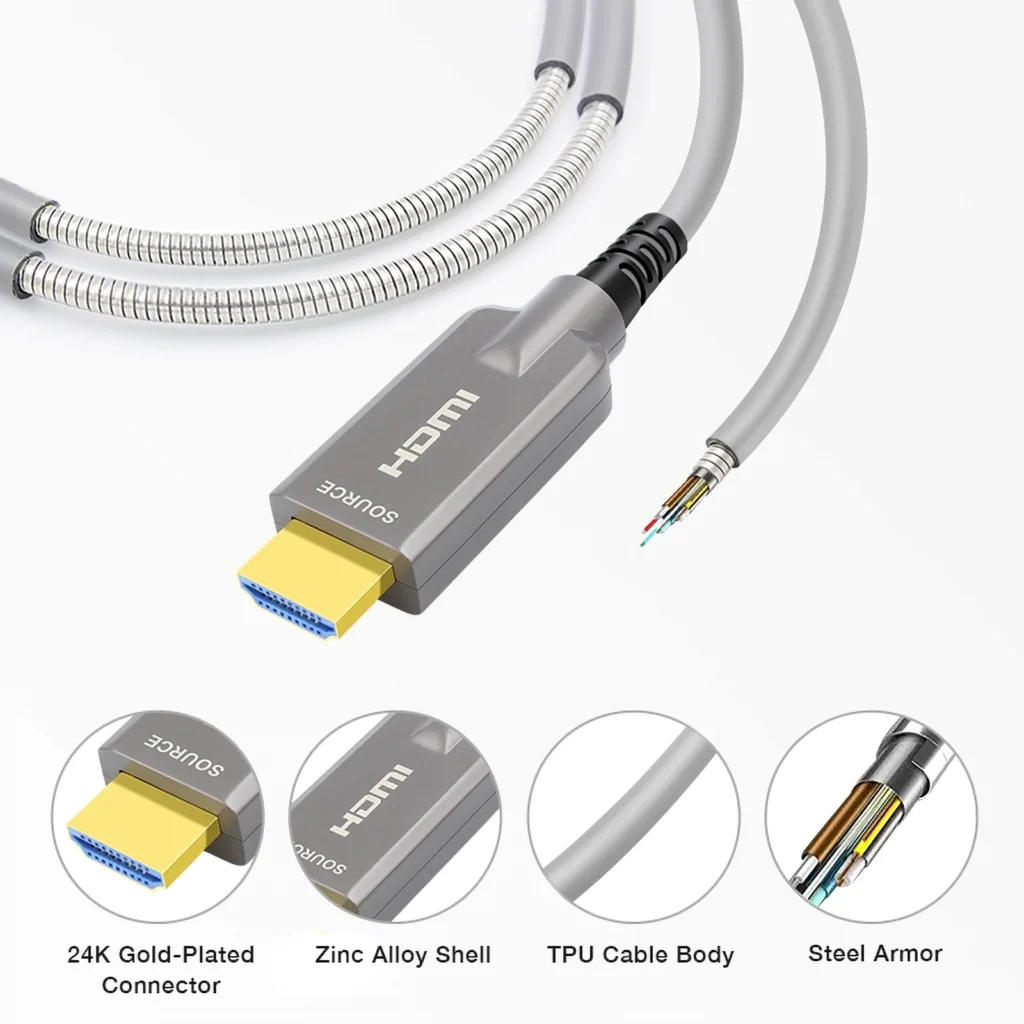
· Cables feature 24K gold-plated connectors to reduce resistance and prevent corrosion, maintaining high-quality audio and video signals.
· Zinc alloy casing provides superior physical protection, enhancing the cable’s durability and lifespan.
· TPU cable body offers flexibility and abrasion resistance, suitable for various installations and frequent handling.
· Stainless steel armor ensures the cable’s integrity and function under extreme conditions.
· Kevlar bulletproof wire gives excellent tensile strength, allowing it to withstand high tension.
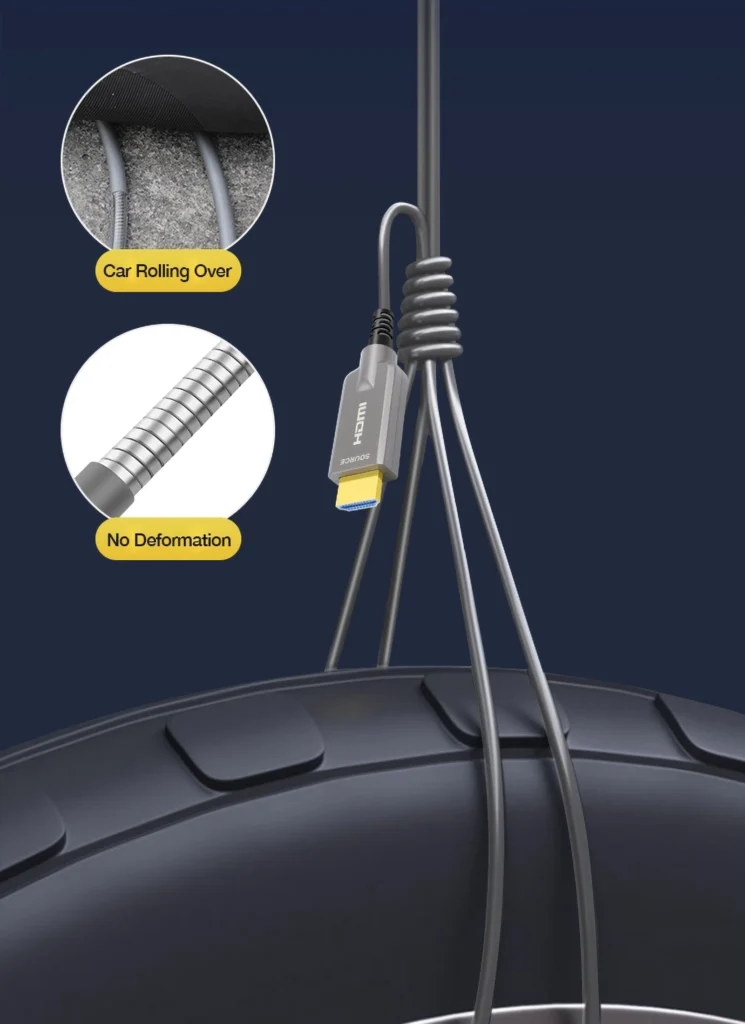
· Wear-resistant TPU exterior and steel armored wire provide extra protection against physical impact, ensuring long-lasting performance in harsh environments.
Designed with extreme conditions in mind:
· Alloy housing and TPU sheath offer superb protection against environmental stresses.
· Cable remains flexible in temperature ranges from -40°C to 120°C.
· Rugged connector design with gold-plated copper connectors provides oxidation and corrosion resistance.
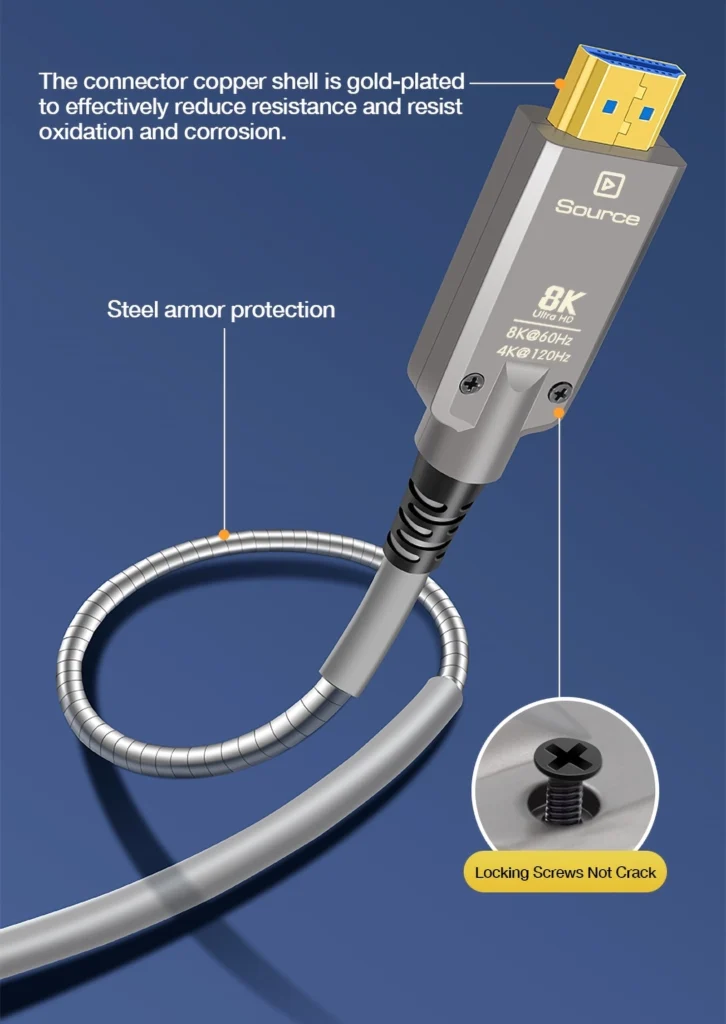
Additionally, this cable is designed for scenarios like cinemas, projects, stages, live broadcasts, performances, and stadiums:
· Features rodent resistance, tensile resistance, and drag resistance.
· Resistance to squeezing and trampling (can withstand being run over by cars) and maintain functionality even under extreme conditions.
These features make it an excellent choice for demanding applications.
5.Device Compatibility
Armored 8K optical fiber HDMI AOC cables are compatible with various output and display devices, enhancing their applicability in different environments:

Output Devices: Compatible with laptops, desktops, set-top boxes, smart boxes, PS5, PS4 Pro, Xbox, and Switch, ensuring high-quality video and audio transmission.
Display Devices: Ideal for use with projectors, monitors, and HDTVs, providing an immersive 8K resolution viewing experience.
6.Wide Range of Application Scenarios
The versatility and robustness of armored 8K optical fiber HDMI AOC cables make them ideal for various applications, meeting both professional and consumer needs. These cables excel in environments requiring high-quality video and audio transmission and support a wide range of specific use cases.
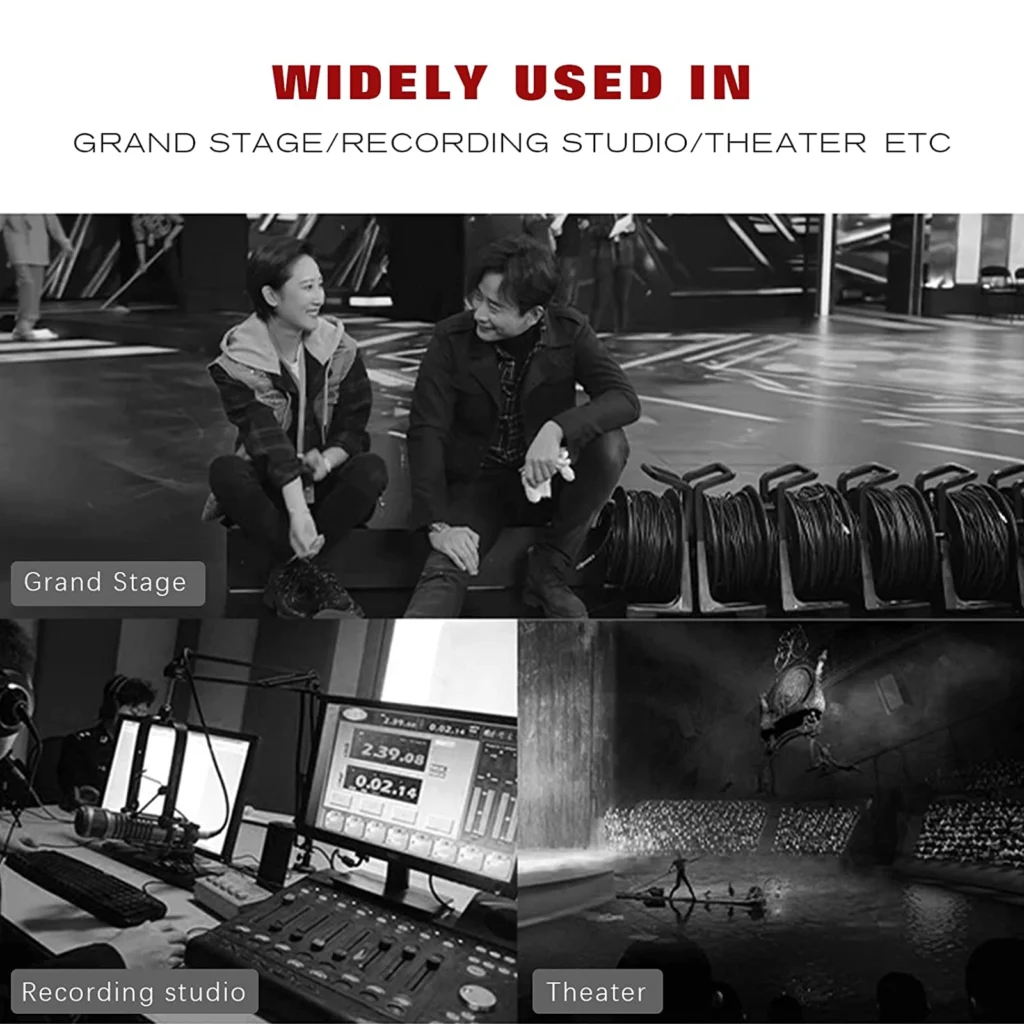
These cables are ideal for large stages, concerts, and live broadcasts, providing reliable high-resolution video and audio transmission in dynamic environments for an immersive experience. In homes and offices, cables can be used for home theaters and video conferencing, providing seamless installation and high-quality communication. In shopping centers, these cables support digital signage and large-screen advertising for continuous operation.
Additionally, in professional video production, these cables ensure lossless signal quality during live broadcasts and recordings. In gaming setups, they offer ultra-HD 8K and 144Hz gaming experiences without delay and signal loss. In event rentals and stage performances, armored HDMI AOC cables are particularly suitable for outdoor events and live performances, enduring harsh conditions, while meeting the long-distance cabling needs for corporate AV installations in conference rooms and digital signage environments.
Various Application Scenarios:
Large Stages and Concerts: Provide reliable and high-quality video/audio transmission, enhancing audience experience.
Live Broadcasting: Deliver uninterrupted high-resolution signals in dynamic environments.
Home Installation: Suitable for seamless installation in embedded home theaters.
Office Video Conferencing: Deliver high-quality communication over long distances.
Shopping Center Displays: Support digital signage and advertising for continuous operation.
Professional Video Production: Ensure lossless signal during live broadcasts and recordings.
Gaming Setups: Achieve 8K and 144Hz gaming experience without delay.
Event Rental and Stage Performances: Resist harsh conditions, suitable for outdoor and live performances.
Corporate AV Installations: Suitable for long-distance cabling in conference rooms and signage needs.
In conclusion, the choice between armored 8K optical fiber HDMI AOC cables and standard cables largely depends on the intended application. For scenarios involving rough handling, outdoor activities, or frequent relocation, the armored version is a worthwhile investment. Conversely, standard 8K HDMI AOC cables suffice for typical home theater setups.
For those seeking a combination of performance and durability at a competitive price, AOCFiberlink’s armored cables present an excellent choice, positioning them as a strong alternative to other high-end brands on the market.
FAQ
Q1: Is there a difference between HDMI cables?
1. Version: There are several versions of HDMI cables, such as HDMI 1.4, 2.0, and 2.1. Each version supports different resolutions and refresh rates. For example, HDMI 2.1 supports up to 8K resolution at 60Hz and includes features such as variable refresh rate (VRR) and enhanced audio return channel (eARC), making it ideal for high-performance applications such as gaming and home theater.
2. Material: The materials used in HDMI cables can vary greatly. Standard HDMI cables typically use copper conductors, while fiber optic HDMI cables use light to transmit signals, allowing for longer distances without signal degradation. Armored fiber optic HDMI cables use additional protective materials, such as metal or Kevlar, to enhance their durability and resistance to physical damage.
3. Protective features: Armored fiber optic HDMI cables are designed with a rugged protective layer to protect the cable from harsh environments, physical shock, and abrasion. This makes them particularly suitable for demanding applications such as outdoor events, rental services and installations where cables are frequently moved or exposed to potential hazards.
In summary, while all HDMI cables have the basic function of transmitting video and audio signals, the choice of version, material and protection features can significantly affect their performance and suitability for different applications.
Q2: What is the difference between fiber optic HDMI and regular HDMI?
A2: There are significant differences between fiber optic HDMI cables and regular HDMI cables in terms of transmission technology, signal quality, and durability:
1. Transmission technology:
Regular HDMI cables: Use copper conductors to transmit electrical signals. This limits their effective range, as signal quality degrades over longer distances.
Fiber optic HDMI cables: Utilize light to transmit signals, allowing for longer distances without signal degradation. This makes them ideal for large-scale installations where maintaining high-quality video and audio is critical.
2. Signal quality and distance:
Regular HDMI cables: Typically suitable for shorter distances, up to about 15 meters, before a signal booster or repeater is required.
Fiber optic HDMI cables: Able to maintain excellent signal integrity over distances of up to 500 meters, making them suitable for professional and commercial applications that require long-distance cables.
3. Durability and environmental resistance:
Regular HDMI cables: Typically less resistant to environmental factors and physical damage.
Armored Fiber Optic HDMI Cables: Features a protective layer such as metal or Kevlar that offers excellent resistance to cuts, abrasions, and impacts. This makes them suitable for harsh environments and applications that are frequently moved or exposed to potential hazards.
4. Use Cases and Flexibility:
Regular HDMI Cables: Best suited for stable environments such as home theaters or offices, where flexibility and ease of use are prioritized.
Fiber Optic HDMI Cables: Ideal for demanding conditions such as live events, outdoor installations, and industrial environments, where long-distance transmission and durability are critical.
In summary, while regular HDMI cables are adequate for everyday use in controlled environments, fiber optic HDMI cables offer significant advantages in distance, signal quality, and durability, especially in demanding or professional environments.
Q3: What is the difference between armored cable and normal cable?
A3: Armored cables and regular cables differ greatly in construction, durability, flexibility, and intended use. Here is a detailed comparison:
1. Construction and Materials:
Regular cables: are usually made of ordinary materials, such as plastic insulation PVC, etc. to provide basic protection against environmental factors.
Armored cables: have a strong protective layer, usually made of metal or Kevlar fiber TPU, wrapped around the fiber core. This structure has excellent resistance to physical damage such as cuts, abrasions, and impacts.
2. Durability and Protection:
Regular cables: are more susceptible to physical pressure and environmental damage, so they are not well suited for harsh conditions.
Armored cables: are designed to withstand harsh environments and physical impacts, such as being run over by vehicles, without deforming. This makes them ideal for industrial applications, outdoor activities, and scenarios where cables are often moved or exposed to potential hazards.
3. Flexibility and Weight:
Regular cables: are usually more flexible and lighter, suitable for installations that require tight bends and easy handling.
Armored cables: slightly less flexible and heavier due to the added protective layer. While this may reduce its flexibility, it greatly increases its durability and lifespan.
4. Use Cases and Costs:
Ordinary cables: Best suited for relatively small and stable environments, such as home theaters or office spaces, where cable length is not a big requirement and extreme durability is not required. The price is slightly lower.
Armored cables: Designed for harsh conditions such as long-distance frequent movement in extreme environments, such as live events, rental applications, and industrial environments. Although they are generally more expensive due to material and structural enhancements, their superior durability and longer service life justify this cost.
In summary, while ordinary cables are sufficient for daily use in controlled environments, armored cables have significant advantages in durability, protection, and suitability for challenging applications. This makes them a worthwhile investment for scenarios involving rough handling, outdoor activities, or frequent relocation.
Q4: What is armored fiber cable?
A4: Armored fiber optic cables are a special type of fiber optic cable designed with enhanced durability and protection, making them suitable for challenging environments. Their structure, materials, and application scenarios are described in detail below:
1. Structure and Materials:
Protective Layer: Armored fiber optic cables are reinforced with a sturdy protective layer, usually made of materials such as metal or Kevlar. This armor layer has excellent resistance to physical damage such as cuts, abrasions, and impacts.
Core Technology: These cables use advanced fiber optic technology to allow high-speed data transmission over long distances without signal degradation. The use of a 4-core 12G fiber core ensures high-speed data transmission and minimizes signal loss.
Additional Reinforcement: Multi-strand tinned copper core and Kevlar fiber reinforcement enhance tensile strength, allowing the cable to resist physical stress. Aluminum foil shielding prevents electromagnetic interference and ensures stable signal transmission.
2. Advantages:
Strong Protection: The armored design provides excellent defense against physical damage, making these cables ideal for harsh environments.
Extended Durability: Reinforced construction ensures longer service life, even in harsh conditions, such as being run over by a vehicle without deforming.
Excellent Signal Integrity: Armored fiber optic cables maintain excellent signal quality over distances up to 500 meters, which is critical in high EMI environments.
Q5: What is the purpose of armored cable?
A5: Armored cables play a vital role in providing enhanced protection and durability in environments where cables are exposed to potential physical damage and harsh conditions. Below is a more detailed analysis of their uses, highlighting their wide range of applications:
1. Protection against physical damage: Armored cables are designed with a rugged protective layer, such as metal or Kevlar, that protects internal components from cuts, abrasions, impacts, and other physical stresses. This makes them ideal for environments where cables may be run over by vehicles or impacted by heavy machinery.
2. Durability in harsh environments: The reinforced construction of armored cables ensures that they can withstand challenging conditions, such as extreme temperatures, moisture, and exposure to chemicals. This durability makes them suitable for industrial applications, outdoor activities, and public facilities where reliability is critical.
3. Maintaining signal integrity: Armored cables, especially those using fiber optic technology, maintain excellent signal quality over long distances. The protective armor prevents electromagnetic interference, ensuring stable and reliable data transmission, which is critical for high-resolution video and audio applications.
4. Versatility in application scenarios:
Industrial and public facilities: Ideal for environments that require strong protection, such as industrial applications, public facilities, and harsh outdoor environments.
Live events and stage performances: Suitable for dynamic environments such as large stages, concerts, and live broadcasts, reliable high-resolution video and audio transmission is essential.
Home and office use: Although these cables are more commonly used in harsh conditions, they can also be used in home theater and office settings where durability is a priority.
Professional video production: Ensures lossless signal quality during live broadcasts and recordings, making it valuable in professional video production environments.
Gaming settings: Provides a lag-free ultra-high-definition 8K and 144Hz gaming experience, providing high-quality video and audio transmission for gaming enthusiasts.
Shopping malls and digital signage: Supports the continuous operation of digital signage and large-screen advertising, ensuring high-quality displays in commercial environments.
In short, the purpose of armored cables is to provide strong protection and ensure reliable performance in harsh conditions. Its enhanced durability and ability to maintain signal integrity make it a valuable investment in scenes involving rough handling, outdoor activities, or frequent relocation. The wide range of applications highlights their versatility and importance in professional and consumer environments.
Q6: When to use armored cables?
A6: Armored cables are essential in environments where cables are exposed to potential physical damage and harsh conditions. Here are the scenarios and needs they address:
1. Protection against physical damage: Armored cables are designed with a rugged protective layer, such as metal or Kevlar, that protects internal components from cuts, abrasions, impacts, and other physical stresses. This makes them ideal for environments where cables may be run over by vehicles or hit by heavy machinery.
2. Durability in harsh environments: The reinforced structure of armored cables ensures that they can withstand challenging conditions, such as extreme temperatures, moisture, and exposure to chemicals. This durability makes them suitable for industrial applications, outdoor activities, and public facilities where reliability is critical.
3. Maintaining signal integrity: Armored cables, especially those using fiber optic technology, maintain excellent signal quality over long distances. The protective armor prevents electromagnetic interference, ensuring stable and reliable data transmission, which is essential for high-resolution video and audio applications.
4. Versatility in application scenarios:
Industrial and public facilities: Ideal for environments that require strong protection, such as industrial applications, public facilities, and harsh outdoor environments.
Live Events and Stage Performances: Suitable for dynamic environments such as large stages, concerts, and live broadcasts, reliable high-resolution video and audio transmission is essential.
Home and Office Use: While these cables are more often used in harsh conditions, they can also be used in home theater and office environments where durability is a priority.
Professional Video Production: Ensures lossless signal quality during live broadcasts and recordings, making it valuable in professional video production environments.
Gaming Settings: Provides a lag-free UHD 8K and 144Hz gaming experience, providing high-quality video and audio transmission for gaming enthusiasts.
Malls and Digital Signage: Supports continuous operation of digital signage and large-screen advertising, ensuring high-quality displays in commercial environments.
In summary, armored cables should be used in scenarios involving rough handling, outdoor activities, or frequent relocation. Its enhanced durability and ability to maintain signal integrity make it a valuable investment in professional and consumer environments, meeting the need for reliable performance in challenging conditions.
Über uns
Bei AOCFiberlinkWir sind auf die Herstellung hochwertiger Produkte spezialisiert fiber optical USB cables & fiber optical HDMI cables that cater to the demands of modern audiovisual systems. Our fiber optical USB & HDMI cables are designed to deliver uncompromising performance, ensuring that you enjoy the true potential of your high-definition devices.
Besides the standard fiber optic HDMI Cables & fiber optical USB Cables, we also provide tailor-made solutions for customer specific needs.
Please don’t hesitate to contact us.
You can also subscribe to our Youtube channel to stay tuned.




